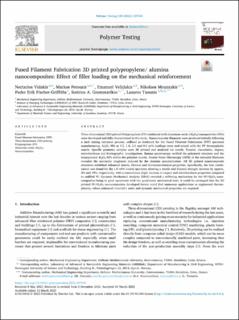| dc.contributor.author | Vidakis, Nectarios | |
| dc.contributor.author | Petousis, Markos | |
| dc.contributor.author | Velidakis, Emanuel | |
| dc.contributor.author | Mountakis, Nikolaos | |
| dc.contributor.author | Fischer-Griffiths, Peder Erik | |
| dc.contributor.author | Grammatikos, Sotirios | |
| dc.contributor.author | Tzounis, Lazaros | |
| dc.date.accessioned | 2023-01-24T07:39:31Z | |
| dc.date.available | 2023-01-24T07:39:31Z | |
| dc.date.created | 2022-05-04T09:12:04Z | |
| dc.date.issued | 2022 | |
| dc.identifier.citation | Polymer testing. 2022, 109 . | en_US |
| dc.identifier.issn | 0142-9418 | |
| dc.identifier.uri | https://hdl.handle.net/11250/3045616 | |
| dc.description.abstract | Three-dimensional (3D) printed Polypropylene (PP) reinforced with aluminum oxide (Al2O3) nanoparticles (NPs) were developed and fully characterized in this study. Nanocomposite filaments were produced initially following a melt mixing extrusion process, utillised as feedstock for the Fused Filament Fabrication (FFF) specimen manufacturing. Al2O3 NPs at 0.5, 1.0, 2.0 and 4.0 wt% loadings were melt-mixed with the PP thermoplastic matrix. Specific geometry samples were 3D printed and analysed via tensile, flexural, viscoelastic, impact, microhardness and fractographic investigations. Raman spectroscopy verified the polymeric structure and the incorporated Al2O3 NPs within the polymer matrix. Atomic Force Microscopy (AFM) of the extruded filaments revealed the nanoscale roughness induced by the alumina nanoinclusions. All 3D printed nanocomposite structures exhibited enhanced tensile, flexural and thermomechanical properties. Specifically, the best combination was found for the 1.0 wt% loaded specimen showing a tensile and flexural strength increase by approx. 4% and 19%, respectively, with a concomitant slight increase in impact and microhardness properties compared to unfilled PP. Dynamic Mechanical Analysis (DMA) revealed a stiffening mechanism for the PP/Al2O3 nanocomposites being in good agreement with the quasi-static mechanical tests. It could be envisaged that the 3D printed PP/Al2O3 nanocomposites developed herein could find numerous applications as engineered thermoplastics, where enhanced material's static and dynamic mechanical properties are required. | en_US |
| dc.language.iso | eng | en_US |
| dc.publisher | Elsevier | en_US |
| dc.rights | Attribution-NonCommercial-NoDerivatives 4.0 Internasjonal | * |
| dc.rights.uri | http://creativecommons.org/licenses/by-nc-nd/4.0/deed.no | * |
| dc.title | Fused Filament Fabrication 3D printed polypropylene/ alumina nanocomposites: Effect of filler loading on the mechanical reinforcement | en_US |
| dc.title.alternative | Fused Filament Fabrication 3D printed polypropylene/ alumina nanocomposites: Effect of filler loading on the mechanical reinforcement | en_US |
| dc.type | Peer reviewed | en_US |
| dc.type | Journal article | en_US |
| dc.description.version | publishedVersion | en_US |
| dc.source.pagenumber | 14 | en_US |
| dc.source.volume | 109 | en_US |
| dc.source.journal | Polymer testing | en_US |
| dc.identifier.doi | 10.1016/j.polymertesting.2022.107545 | |
| dc.identifier.cristin | 2021249 | |
| cristin.ispublished | true | |
| cristin.fulltext | original | |
| cristin.qualitycode | 1 | |

